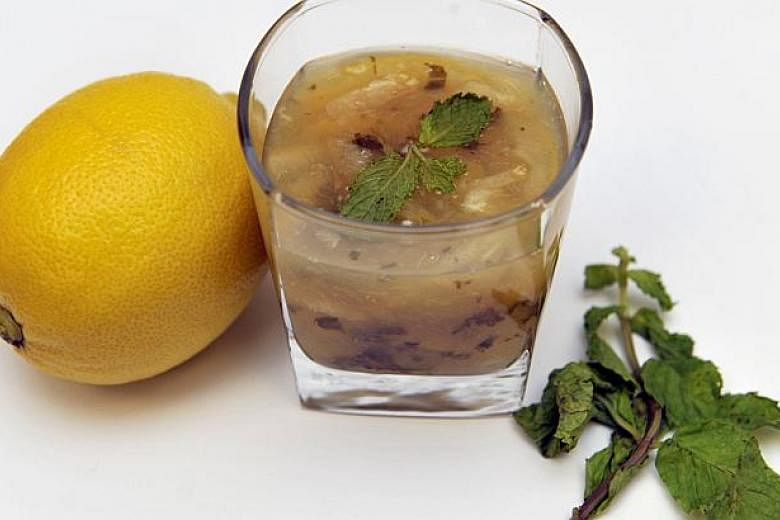This story was first published in Mind Your Body on July 11, 2013.
WHAT IT IS: The clean smell of peppermint is one you are probably familiar with when it comes to food, beverages and even toiletries.
Known as bohe in Chinese, the peppermint plant has menthol (a form of volatile oil) in its leaves, which can be used fresh or dried in traditional Chinese medicine (TCM).
Ms Lim Sock Ling, a TCM practitioner at Bao Zhong Tang TCM Centre, said the herb is mainly grown in China and harvested in summer and autumn. Those originating from the province of Jiangsu are known to be of the best quality.
Ms Lim said in choosing good quality fresh peppermint, the leaves should be dark green, smooth, free of contaminants and have a glossy sheen.
Fresh peppermint leaves are sold at $0.90 for a 50g packet at some supermarkets, while dried peppermint leaves are sold at $1 for a tael (37.5g) at some medical halls here.
HOW TCM USES IT: The pungent-tasting peppermint is considered cool in nature and is said to move through the meridians of the lungs and liver.
Meridians are channels in the body through which qi (vital energy) travels. A good flow of qi in the body is needed for good health.
With its two properties of being pungent and cool, it is used to help disperse symptoms caused by "wind" and "heat". These include fever, headache, sore throat, slight aversion to wind and cold and a lack of perspiration, Ms Lim said.
In TCM, any element that does not coexist with the body disrupts its internal energy and, hence, is regarded as a pathogen.
Based on the symptoms associated with the haze - respiratory tract symptoms such as cough, stuffy nose and throat discomfort - the haze is known as a pathogen in the form of wind and heat.
In TCM, the lung system prefers a moist environment, and the cool peppermint has a moistening effect on lung-related symptoms caused by the haze.
Peppermint is also beneficial to the liver.
The liver is closely linked to one's emotions, said Ms Lim, noting that when a person is angry, stressed or depressed, qi does not flow well through the liver meridian.
As this connects to the chest region, the stagnation of qi in the liver leads to swelling of the breasts and an oppressed feeling in the chest.
As the liver also plays a role in storing blood, this qi stagnation leads to poor blood flow and gives rise to gynaecological problems such as irregular menstruation and clots in the menses, Ms Lim explained.
Peppermint is used in such cases to improve the flow of qi in the liver.
In addition, it is used to promote the eruption of rashes, such as those in measles and rubella (a viral disease characterised by fever, mild upper respiratory congestion and a fine red rash), so as to hasten recovery for the patient.
WHO IT IS FOR: People suffering from haze-related ailments, such as cough, headache and throat discomfort, can use between 3 and 6g of the herb daily.
Ms Lim said over-consuming peppermint can cause problems such as nausea, giddiness, stomachache and numbness of the limbs.
WHO SHOULD AVOID IT: Those who perspire a lot should refrain from using this herb, which will aggravate the sweating due to its pungent property, Ms Lim said.
Peppermint is also known to inhibit the production of milk, so mothers who are breastfeeding should avoid the herb too, she added.
WHAT RESEARCH HAS SHOWN: A study published in the Journal Of The International Society of Sports Nutrition in March showed that peppermint helped enhance athletic performance.
The study had 12 healthy male university students each consume 500ml of mineral water containing 0.05ml of peppermint essential oil, every day for 10 days.
The authors from the University of Mohaghegh Ardabili in Iran found that the performance of participants on a treadmill test significantly improved after they had used the peppermint essential oil for 10 days.
In addition, participants had improved lung function, reduced resting and exercise heart rates, as well as lower blood pressure after exercise.
Recipe
Lemon mint drink
(Serves two to three)
INGREDIENTS
2 lemons
100g rock sugar
300ml water
12 to 15 peppermint leaves
Honey, as desired
METHOD
Wash the lemons well. Peel off the skin and set this aside.
Remove the white pith, which is bitter, and chop the flesh into chunks.
Add 100g of rock sugar to 300ml of water and bring to the boil.
When the mixture is boiling, add the lemon flesh and skin.
Allow the mixture to simmer for approximately
30 minutes or until the texture becomes thick and sticky. In the meantime, shred or chop the peppermint leaves before adding them to the mixture three to five minutes before turning off the flame.
Do not cook the peppermint leaves for more than five minutes to avoid reducing their efficacy.
Allow the contents to cool.
Then add an appropriate quantity of honey.
Keep the mixture refrigerated.
Take one to two teaspoons per day, and add an appropriate amount of warm or chilled water according to one's preference.
Source: Ms Lim Sock Ling, a traditional Chinese medicine practitioner at Bao Zhong Tang TCM Centre


